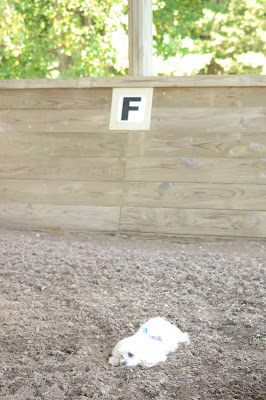Not all eventers share my love for dressage. It is truly a shame to see how many riders completely disregard the basis of all training in the effort of spending more of their time jumping. I was entirely disheartened to see that at the Dreamcrest Horse Trials this past weekend one rider had a penalty score of 90.0 at Training Level and another scored a 94.5. Honestly, if I went to a show and scored that poorly, it would be time to pack up and head home because I would have clearly missed a couple steps in preparing my horse for the event. I understand that accidents happen, horses will have bad or spooky days, but the amount of things that must go wrong to result in a score that poor is astronomical. Bettina Hoy took Lanfranco to Burghley this past weekend and retired during her dressage test due to his inability to cope with the atmosphere. That is an appropriate response; when something is so wrong that your mount becomes unsafe and unable to relax, it is time to call it a day. Continuing to compete with a mount and rider combination unable to execute the basic training requirements in the dressage test makes the pair a danger to themselves, their fellow competitors, and everyone else at the event. (Thank you, I will now step down from my soapbox.)
Tristan and I had the amazing opportunity to train again with the lovely Ilse Schwarz at Cross Creek Farm in Columbus, NC. Last time she gave me a large array of tips and tricks to combat Tristan's naughty pony side that loves to rear its ugly head during stressful situations (i.e. shows). I was very eager to show her how much Tristan and I have improved in the past 2 months using her techniques and excited to see what new things we could work on.
To take full advantage of the three day clinic, of which I only rode one day, auditing was my best friend. I watched most of the rides on Saturday, and greatly enjoyed taking in the training and conversations with each horse and rider pairing. Many different skill levels attended the clinic, ranging from seasoned Grand Prix mounts, young up and coming babies, green older horses, and green riders. This allowed for incredible listening pleasure as Ilse used her wide skill set to best address each pair.
 |
| Dressage is hard! |
Here were a few of my favorite points:
1) The importance of tempo
Tempo can be maintained with the rhythm of posting. This is especially important with a horse that rushes forwards and will translate the flat rushing gait into a more powerful lilt at a slower tempo.
With the different types of trot (extensions to collections to passage) don't ever give up the tempo.
2) Ride the young horse like an underdeveloped FEI horse
When working with a young or green horse, just because you aren't putting them into an upper level frame doesn't mean that you need to sacrifice the necessary building blocks to get there eventually.
3) Remember how to ride
Just because you have an instructor telling you what to fix in your riding, don't sacrifice your own instincts and keep your brain engaged while listening. (Lord knows how easy it is to turn into a lesson robot and stop thinking for yourself.)
Here are some of my favorite photos from the first day of the clinic.
Last time, Ilse gave me tools to counter Tristan's ability to avoid working his body correctly. This time we focused on raising the bar and expecting more out of him through lateral work, his gaits, and his self-carriage. Tristan would like me to convey that this is very difficult for him and he would much rather jump 50 cross country fences than do a correct trot-canter transition in self-carriage. Ilse immediately identified Tristan's main problem area; multitasking. He would prefer to only do one of three things. 1) Have impulsion 2) Lateral movement 3) Roundness. Attempting two of those things at the same time, or god-forbid three, is nearly impossible. We spent most of the ride convincing him that he is more than capable of doing all three.
I was very excited at how much improvement I can feel since my last dressage lesson. Our counter-canter has become much more balanced, and his transitions are getting more through every day. We still have a lot of homework to practice before our next event, but the stepping stones along the way are very clearly defined.
My favorite moment in the lesson was when riding the counter-canter through the short side of the arena. Ilse said to me, "Ride him into your outside knee." I visualized that and immediately felt our balance improve. She told me that young horses do not recognize a "right" or "wrong" lead to canter on. Through training, we teach them the correct lead in relation to direction of travel. Once we introduce the counter-canter, we need to abolish the notion that the horse can only travel on the correct lead when traveling in a particular direction. The less we focus on "right" and "wrong," the less the horse will focus on it.
We have two weeks until our next show at Training level, and four weeks until our Preliminary debut. Our work is cut out for us, but I believe with steady practice and consistently raising the bar for ourselves, Tristan and I really have a shot and shining in our next competitions. Not only will we shine, we will do so safely and well within our abilities.
Go, Super(dressage)pony!









No comments:
Post a Comment